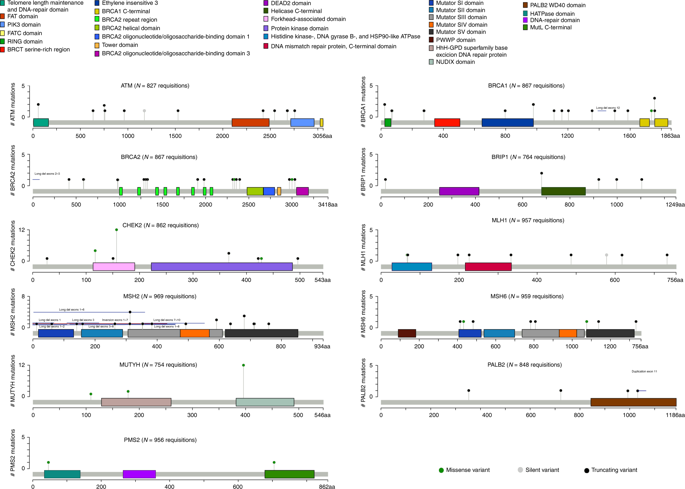当前位置:
X-MOL 学术
›
Genet. Med.
›
论文详情
Our official English website, www.x-mol.net, welcomes your feedback! (Note: you will need to create a separate account there.)
Prevalence of pathogenic germline cancer risk variants in high-risk urothelial carcinoma.
Genetics in Medicine ( IF 8.8 ) Pub Date : 2019-12-17 , DOI: 10.1038/s41436-019-0720-x Amin H Nassar 1, 2 , Sarah Abou Alaiwi 1 , Saud H AlDubayan 3, 4, 5 , Nicholas Moore 3, 5 , Kent W Mouw 6 , David J Kwiatkowski 1, 2 , Toni K Choueiri 1, 2 , Catherine Curran 1 , Jacob E Berchuck 1 , Lauren C Harshman 1 , Pier V Nuzzo 1 , Nieves Martinez Chanza 1 , Eliezer Van Allen 3, 5 , Edward D Esplin 7 , Shan Yang 7 , Thomas Callis 7 , Judy E Garber 8 , Huma Q Rana 8 , Guru Sonpavde 1
Genetics in Medicine ( IF 8.8 ) Pub Date : 2019-12-17 , DOI: 10.1038/s41436-019-0720-x Amin H Nassar 1, 2 , Sarah Abou Alaiwi 1 , Saud H AlDubayan 3, 4, 5 , Nicholas Moore 3, 5 , Kent W Mouw 6 , David J Kwiatkowski 1, 2 , Toni K Choueiri 1, 2 , Catherine Curran 1 , Jacob E Berchuck 1 , Lauren C Harshman 1 , Pier V Nuzzo 1 , Nieves Martinez Chanza 1 , Eliezer Van Allen 3, 5 , Edward D Esplin 7 , Shan Yang 7 , Thomas Callis 7 , Judy E Garber 8 , Huma Q Rana 8 , Guru Sonpavde 1
Affiliation

|
PURPOSE
To date, there has not been a large, systematic evaluation of the prevalence of germline risk variants in urothelial carcinoma (UC).
METHODS
We evaluated the frequency of germline pathogenic and likely pathogenic variants in 1038 patients with high-risk UC who underwent targeted clinical germline testing. Case-control enrichment analysis was performed to screen for pathogenic variant enrichment in 17 DNA repair genes in 1038 UC patients relative to cancer-free individuals.
RESULTS
Among 1038 patients with UC, the cumulative frequency of patients with pathogenic variants was 24%; 18.6% of patients harbored ≥1 actionable germline variant with preventive or therapeutic utility. MSH2 (34/969, 3.5%) and BRCA1/2 (38/867, 4.4%) germline variants had the highest frequency. Germline variants in DNA damage repair genes accounted for 78% of pathogenic germline variants. Compared to the cancer-free cohort, UC patients had significant variant enrichment in MSH2 (odds ratio [OR]: 15.4, 95% confidence interval [CI]: 7.1-32.7, p < 0.0001), MLH1 (OR: 15.9, 95% CI: 4.4-67.7, p < 0.0001), BRCA2 (OR: 5.7, 95% CI: 3.2-9.6, p < 0.0001), and ATM (OR: 3.8, 95% CI: 1.8-8.3, p = 0.02).
CONCLUSION
In this study, 24% of UC patients harbored pathogenic germline variants and 18.6% had clinically actionable variants. MLH1 and MSH2 were validated as UC risk genes while ATM and BRCA2 were highlighted as potential UC predisposition genes. This work emphasizes the utility of germline testing in selected high-risk UC cohorts.
中文翻译:

高危尿路上皮癌中致病性生殖系癌症风险变异的患病率。
目的 迄今为止,尚未对尿路上皮癌 (UC) 中生殖系风险变异的患病率进行大规模、系统的评估。方法 我们评估了 1038 名接受靶向临床生殖系检测的高危 UC 患者的生殖系致病变异和可能致病变异的频率。进行病例对照富集分析以筛选 1038 名 UC 患者相对于无癌症个体的 17 个 DNA 修复基因中的致病变异富集。结果 1038 例 UC 患者中,致病变异患者的累积频率为 24%;18.6% 的患者携带≥1 个具有预防或治疗用途的可操作种系变异。MSH2 (34/969, 3.5%) 和 BRCA1/2 (38/867, 4.4%) 种系变异的频率最高。DNA 损伤修复基因中的种系变异占致病性种系变异的 78%。与无癌症队列相比,UC 患者的 MSH2 变异显着富集(优势比 [OR]:15.4,95% 置信区间 [CI]:7.1-32.7,p < 0.0001),MLH1(OR:15.9,95% CI:4.4-67.7,p < 0.0001),BRCA2(OR:5.7,95% CI:3.2-9.6,p < 0.0001)和 ATM(OR:3.8,95% CI:1.8-8.3,p = 0.02)。结论 在这项研究中,24% 的 UC 患者携带致病性种系变异,18.6% 具有临床上可操作的变异。MLH1 和 MSH2 被验证为 UC 风险基因,而 ATM 和 BRCA2 被强调为潜在的 UC 易感基因。这项工作强调了生殖系检测在选定的高风险 UC 队列中的效用。UC 患者的 MSH2 变异显着富集(优势比 [OR]:15.4,95% 置信区间 [CI]:7.1-32.7,p < 0.0001),MLH1(OR:15.9,95% CI:4.4-67.7,p < 0.0001)、BRCA2 (OR: 5.7, 95% CI: 3.2-9.6, p < 0.0001) 和 ATM (OR: 3.8, 95% CI: 1.8-8.3, p = 0.02)。结论 在这项研究中,24% 的 UC 患者携带致病性种系变异,18.6% 具有临床上可操作的变异。MLH1 和 MSH2 被验证为 UC 风险基因,而 ATM 和 BRCA2 被强调为潜在的 UC 易感基因。这项工作强调了生殖系检测在选定的高风险 UC 队列中的效用。UC 患者的 MSH2 变异显着富集(优势比 [OR]:15.4,95% 置信区间 [CI]:7.1-32.7,p < 0.0001),MLH1(OR:15.9,95% CI:4.4-67.7,p < 0.0001)、BRCA2 (OR: 5.7, 95% CI: 3.2-9.6, p < 0.0001) 和 ATM (OR: 3.8, 95% CI: 1.8-8.3, p = 0.02)。结论 在这项研究中,24% 的 UC 患者携带致病性种系变异,18.6% 具有临床上可操作的变异。MLH1 和 MSH2 被验证为 UC 风险基因,而 ATM 和 BRCA2 被强调为潜在的 UC 易感基因。这项工作强调了生殖系检测在选定的高风险 UC 队列中的效用。结论 在这项研究中,24% 的 UC 患者携带致病性种系变异,18.6% 具有临床上可操作的变异。MLH1 和 MSH2 被验证为 UC 风险基因,而 ATM 和 BRCA2 被强调为潜在的 UC 易感基因。这项工作强调了生殖系检测在选定的高风险 UC 队列中的效用。结论 在这项研究中,24% 的 UC 患者携带致病性种系变异,18.6% 具有临床上可操作的变异。MLH1 和 MSH2 被验证为 UC 风险基因,而 ATM 和 BRCA2 被强调为潜在的 UC 易感基因。这项工作强调了生殖系检测在选定的高风险 UC 队列中的效用。
更新日期:2019-12-17
中文翻译:

高危尿路上皮癌中致病性生殖系癌症风险变异的患病率。
目的 迄今为止,尚未对尿路上皮癌 (UC) 中生殖系风险变异的患病率进行大规模、系统的评估。方法 我们评估了 1038 名接受靶向临床生殖系检测的高危 UC 患者的生殖系致病变异和可能致病变异的频率。进行病例对照富集分析以筛选 1038 名 UC 患者相对于无癌症个体的 17 个 DNA 修复基因中的致病变异富集。结果 1038 例 UC 患者中,致病变异患者的累积频率为 24%;18.6% 的患者携带≥1 个具有预防或治疗用途的可操作种系变异。MSH2 (34/969, 3.5%) 和 BRCA1/2 (38/867, 4.4%) 种系变异的频率最高。DNA 损伤修复基因中的种系变异占致病性种系变异的 78%。与无癌症队列相比,UC 患者的 MSH2 变异显着富集(优势比 [OR]:15.4,95% 置信区间 [CI]:7.1-32.7,p < 0.0001),MLH1(OR:15.9,95% CI:4.4-67.7,p < 0.0001),BRCA2(OR:5.7,95% CI:3.2-9.6,p < 0.0001)和 ATM(OR:3.8,95% CI:1.8-8.3,p = 0.02)。结论 在这项研究中,24% 的 UC 患者携带致病性种系变异,18.6% 具有临床上可操作的变异。MLH1 和 MSH2 被验证为 UC 风险基因,而 ATM 和 BRCA2 被强调为潜在的 UC 易感基因。这项工作强调了生殖系检测在选定的高风险 UC 队列中的效用。UC 患者的 MSH2 变异显着富集(优势比 [OR]:15.4,95% 置信区间 [CI]:7.1-32.7,p < 0.0001),MLH1(OR:15.9,95% CI:4.4-67.7,p < 0.0001)、BRCA2 (OR: 5.7, 95% CI: 3.2-9.6, p < 0.0001) 和 ATM (OR: 3.8, 95% CI: 1.8-8.3, p = 0.02)。结论 在这项研究中,24% 的 UC 患者携带致病性种系变异,18.6% 具有临床上可操作的变异。MLH1 和 MSH2 被验证为 UC 风险基因,而 ATM 和 BRCA2 被强调为潜在的 UC 易感基因。这项工作强调了生殖系检测在选定的高风险 UC 队列中的效用。UC 患者的 MSH2 变异显着富集(优势比 [OR]:15.4,95% 置信区间 [CI]:7.1-32.7,p < 0.0001),MLH1(OR:15.9,95% CI:4.4-67.7,p < 0.0001)、BRCA2 (OR: 5.7, 95% CI: 3.2-9.6, p < 0.0001) 和 ATM (OR: 3.8, 95% CI: 1.8-8.3, p = 0.02)。结论 在这项研究中,24% 的 UC 患者携带致病性种系变异,18.6% 具有临床上可操作的变异。MLH1 和 MSH2 被验证为 UC 风险基因,而 ATM 和 BRCA2 被强调为潜在的 UC 易感基因。这项工作强调了生殖系检测在选定的高风险 UC 队列中的效用。结论 在这项研究中,24% 的 UC 患者携带致病性种系变异,18.6% 具有临床上可操作的变异。MLH1 和 MSH2 被验证为 UC 风险基因,而 ATM 和 BRCA2 被强调为潜在的 UC 易感基因。这项工作强调了生殖系检测在选定的高风险 UC 队列中的效用。结论 在这项研究中,24% 的 UC 患者携带致病性种系变异,18.6% 具有临床上可操作的变异。MLH1 和 MSH2 被验证为 UC 风险基因,而 ATM 和 BRCA2 被强调为潜在的 UC 易感基因。这项工作强调了生殖系检测在选定的高风险 UC 队列中的效用。

























 京公网安备 11010802027423号
京公网安备 11010802027423号